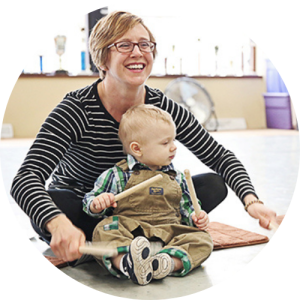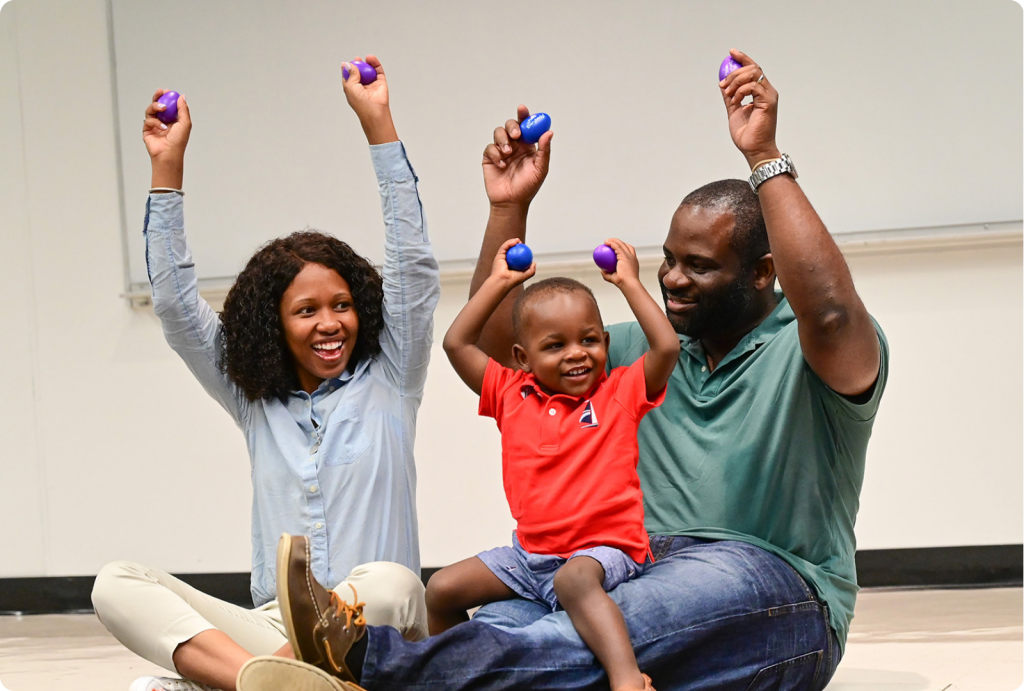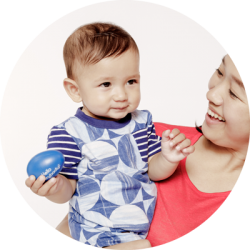Two Songs, Two Instruments
As you sing “Roo, roo, roo, roo. . . Sing roo, sing ho-key din-kum!” (“Sweet Potato”) in your Music Together® class, your teacher might hand out egg shakers and model shaking them high in the air, in front of you, side-to-side, and more. A little later, you might all be clicking rhythm sticks and tapping them on the floor as you sing, “You get a line, I’ll get a pole, honey” (“Crawdad”).

Ever wonder why we use egg shakers and rhythm sticks in Music Together class? Like everything we do, it’s by design! The different methods to play these two child-friendly percussive instruments—and their resulting sounds—both support your child as they learn how to express themselves through music. In each case, movement (cause) elicits sound (effect), giving the child important information about their musical experience.
Let’s look a little deeper into what’s going on.
Shake and Click: Non-impact and Impact-dependent Instruments
- Egg shakers are a type of instrument we call non-impact dependent. When children grip egg shakers in their hands, whenever they move their arms, the instrument makes a “chhhh” sound. Young children respond to music with their whole bodies, so putting egg shakers in their hands helps them connect to (and sometimes control) the music they’re experiencing in the moment.
- Rhythm sticks, on the other hand, are impact dependent instruments, meaning they only make a sound with deliberate movements. A young child shaking their sticks in the air will make no sound at all. One stick tapped on the floor makes a crisp, clear sound, and two sticks clicked together is a completely different kinesthetic experience! The motions needed to draw out sound from the sticks require more developed muscles and coordination than egg shakers.
Both impact-dependent and non-impact dependent instruments provide different and creative ways for the children to interact with musical instruments. According to Music Together Worldwide Program Developer Anne Sailer, “Part of our developmentally appropriate practice in using instruments like eggs and sticks is the way we play WITH the instruments in a non-formal way. This developmental approach scaffolds the emergence of flexible thinking and an improvisational disposition when it comes to experimenting with ways to make music.”
Deeper learning takes place as the child processes the rich aural, kinesthetic, and visual stimuli they experience as they are making music with those around them. Anne explains that this multi-modal learning, where the child is using multiple senses at a time, is part of how children are wired to learn and absorb new information.

Ages and Stages: The Value of Different Types of Instruments for Young Children
Our mixed-age classes bring together children of different ages, different learning styles, and who are at different stages of music and overall development. As you can imagine, an infant’s experience with an egg shaker or a rhythm stick will be very different (but no less valuable) from that of a toddler or preschooler!
For a child who is still developing purposeful movement, discovering that the eggs in their hands make a sound can result in a squeal of delight. For a child who has a more developed ability to make purposeful movement, exploring all the fascinating ways there are to click, rub, tap, and roll their sticks offers a powerful sense of agency and autonomy.
Like all learning, exposure and experimentation over time lead to greater understanding. By giving children lots of opportunities to grasp egg shakers and click sticks together, they have more time to explore, experiment, and play with how to make and control the different sounds. How they “figure it out” is literally, in their hands.

Yes, You Can!
You may not realize it, but YOU are your children’s first, and most important, music teacher. Our children truly want to do what we do! As they watch you shake your eggs and click your sticks (and drums, and resonator bells, etc.), they will begin to try to play with those instruments, too, and their musical skills will continue to deepen.
And remember, you don’t have to be a great singer or dancer (or percussionist!) to make a difference. (Phew!) Actual music skills can be learned from many sources, when your child is ready. Right now, your child is learning the disposition, or desire, to make music by seeing you do it. So sing, dance, play those instruments, and get silly. You’ll be setting your child on the path to a lifetime of musical enjoyment.



